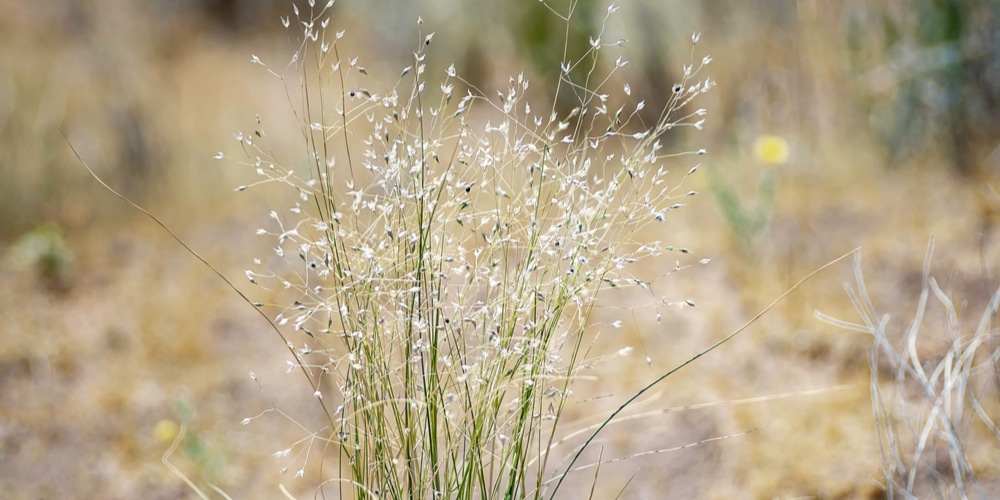Indian ricegrass, known as Achnatherum hymenoides is a perennial ornamental grass that grows in clumps. The plant adapts to various climates and soil conditions and is an excellent option to add texture and volume to your garden.
It is a crucial native forage grass in desertic and semi-desertic areas. But what if you want to grow it in your garden? You have landed in the right place to learn all you need to know about it!

| Botanical Name | Achnatherum hymenoides |
| Common Name | Indian Ricegrass |
| Plant Type | Perennial |
| Flower Color | Wide spreading panicle consisting of hair-like stems, each with a single creamy-white flower at the end. |
| Size When Mature | Up to 2 ft tall |
| Bloom Time | Summer |
| Sun Requirements | Full Sun |
| USDA Hardiness Zones | 3-9 |
| Soil PH Range | 6.0-7.5 |
| Soil Type | Example: Acidic, well-draining |
| Water Needs | Low |
| Native Area | North America |
What you Need to Know About Achnatherum hymenoides
Indian ricegrass is an ancient plant native to North America. It thrives in sandy soils and dry conditions, but it can also adapt to live in a moist area (if the climate is suitable). The plant’s leaves have a slightly rounded appearance at the end, giving this clumping grass a unique-looking texture.
You can identify the plant by looking at its blooms, which come from a large panicle of hair-like stalks that terminate in a single white flower that contains a black seed. You can use the flowers in arrangements, dry or fresh.
The plant is not toxic to humans or animals. Instead, Indian Ricegrass is a highly nutritious plant, high in protein and fibers, and rich in vitamins.
How to Care for Achnatherum hymenoides
Indian ricegrass is a versatile plant that doesn’t require much attention from your side once established. Yet, learning about its needs and requirements can help you get the most out of it. Jump to the following sections to explore everything you need to know about growing a thriving Achnatherum hymenoides.
Light
This native plant thrives in the dry areas of the Western regions of the United States. It performs better under the full sun, where it will produce abundant flowers. Under ideal growing conditions, this perennial will naturally form a ground cover and spread from seed.
Water and Soil Needs
Indian ricegrass doesn’t need much water. Also, it isn’t fussy about its soil conditions, making it an ideal plant to add to “difficult” areas. The plant’s clumping growing habit will create a stunning prairie look, regardless of where you put it.
Indian ricegrass performs best in slightly acidic to alkaline soils, better if well-draining. If your substrate is compact, consider adding some sand or gravel to increase drainage and improve water retention.
Indeed, this plant won’t do well in soggy soil, which might make your plant weaker.
Keep your Indian Ricegrass moist during the establishment period (just after planting it) to encourage healthy root development. After that, you won’t have to water your plant more than once every two weeks.
Temperature Requirements
This plant is native to the desertic and semi-desertic areas of the western regions of the United States. So, it is ideal for growing in USDA hardiness zones from 6-9.
However, its superior versatility allows it to adapt up to zone 3. In a suitable climate, this plant will grow back each year without you having to till it and re-plant it. As a consequence, you can enjoy all-year-round beauty with minimal effort. Some gardeners use it in restoration to prevent (or cure) erosion.
Fertilizer
You won’t have to fertilize this plant, which will perform well in most environments. Still, applying a product rich in nitrogen will boost growth and make your plant stronger. Don’t forget to follow the instructions you find on the product’s label to avoid harming your plant.
Common Diseases
One of the most common issues with Indian Ricegrass is the damage caused by birds, who love to feed on its seeds. Consider covering your plant to limit issues, especially during the summer.
Also, avoid overwatering your plant, which might cause fungal infections and root rotting. Ensure you are planting your grass’s inadequate substrate to prevent overwatering issues.
Additionally, keep an eye out for grasshoppers and rodents, which might damage the plant. In terms of diseases, you shouldn’t worry too much. Indeed, Indian ricegrass has a high tolerance to most infections.
Related article: Pennsylvania Native Grasses
